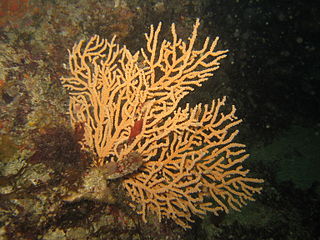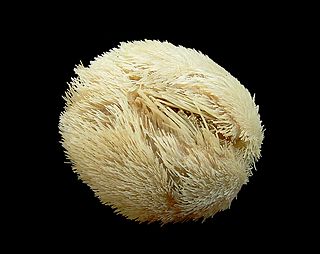Related Research Articles

Atelecyclus rotundatus is a medium-sized crab found on the west coast of Europe and Africa as well as almost all the Mediterranean Sea and on the Cape Verde and Canary islands. It has many common names, including circular crab, round crab and old man's face crab. It measures about 40 millimetres (1.6 in) across its almost circular, reddish-brown carapace and lives on coarse soft bottoms at shallow depths. There are 9–11 sharp teeth on the front and 3 teeth between the eyes.

Nephtys is a genus of marine catworms. Some species are halotolerant to a degree in that they can survive in estuaries and estuarine lagoons down to a salinity of 20 psu.

Eunicella verrucosa, the broad sea fan, pink sea fan or warty gorgonian, is a species of colonial Gorgonian "soft coral" in the family Gorgoniidae. It is native to the north-eastern Atlantic Ocean and the western Mediterranean Sea.
Victorella pavida or trembling sea mat is a species of bryozoans found in shallow waters of low or fluctuating salinity, such as lagoons and estuaries. In summer it can have the appearance of velvet. The zooids may be from 0.3 mm to 1 mm in length. They live in colonies underwater attaching to stones. They feed using tiny hairs attached to their crown of tentacles to catch tiny particles flowing through the water, also known as "filter feeding".

Patella vulgata, common name the common limpet or common European limpet is a species of sea snail. It is a typical true limpet; a marine gastropod mollusc in the family Patellidae, with gills. This species occurs in the waters of Western Europe.
Golfingia vulgaris is a marine invertebrate belonging to the phylum Sipuncula, the peanut worms. It is a cylindrical, unsegmented worm with a crown of tentacles around the mouth. It lives in burrows in shallow seas in various parts of the world.

Liocarcinus holsatus, sometimes known by the common name flying crab, is a species of swimming crab found chiefly in the North Sea, Irish Sea and English Channel. It has a carapace up to 4 centimetres (1.6 in) wide, which is brownish-grey with a green tinge. It is very similar in appearance to the harbour crab Liocarcinus depurator.

Haliclystus auricula is a stalked jellyfish found in the Northern hemisphere. It is the type species for its genus.

Echinocardium cordatum, also known as the common heart urchin or the sea potato, is a sea urchin in the family Loveniidae. It is found in sub-tidal regions in the NE Atlantic. Other un-named species have been identified as this species from temperate seas around the world. It lives buried in the sandy sea floor.

Flustra foliacea is a species of bryozoans found in the northern Atlantic Ocean. It is a colonial animal that is frequently mistaken for a seaweed. Colonies begin as encrusting mats, and only produce loose fronds after their first year of growth. They may reach 20 cm (8 in) long, and smell like lemons. Its microscopic structure was examined by Robert Hooke and illustrated in his 1665 work Micrographia.

Ascidiella aspersa is a species of solitary sea squirts native to the northeastern Atlantic, from the Mediterranean Sea to Norway. They possess oval bodies up to 50 to 130 mm in length. Their branchial siphons are conical and positioned at the top of the body. They possess six to eight lobes. The atrial siphons are located at the upper third of the side of the body and possess six lobes. The body is covered by a firm transparent test that is greyish to brown in color. The test often snag detritus that remain loosely attached to the animal. When expanded, at most 40 tentacles can be observed on the inside surface of the branchial wall. Both the openings of the branchial and atrial siphons possess lighter colored ridges on their rims. They may also be frilled at times. A. aspersa are attached to the substrates by the left side of their bodies. They can be found in dense groups of unfused individuals on hard surfaces like rocks. at depths of up to 90 m (300 ft).

Chorda filum, commonly known as dead man's rope or sea lace among other names, is a species of brown algae in the genus Chorda. It is widespread in the temperate waters of the northern hemisphere. The species also has numerous other common names related to its physical appearance. Names include mermaid's tresses, cat's gut or sea-catgut, bootlace weed, sea-twine, and mermaid's fishing line.

Cerastoderma glaucum, the lagoon cockle, is a species of saltwater clam, a marine bivalve mollusc in the family Cardiidae, the cockles.

Zostera noltii is a species of seagrass known by the common name dwarf eelgrass. It is found in shallow coastal waters in north western Europe, the Mediterranean Sea, Black Sea, Caspian Sea and Aral Sea and on islands in the Atlantic off the coast of northwest Africa. It is an important part of the intertidal and shallow subtidal ecosystems of estuaries, bays and lagoons.

Pachycerianthus multiplicatus, commonly known as the firework anemone, is a species of tube anemone in the family Cerianthidae. This species is found in sheltered, subtidal mud at depths of 10 - 130m.

Actinothoe sphyrodeta, the sandalled anemone, is a small sea anemone in the family Sagartiidae. It is native to the northeastern Atlantic Ocean and is common on the north, west and south coasts of Britain. It is usually grey or whitish but may have an orange oral disc. The translucent white tentacles that grow around the edge of the oral disc can number up to 120.
Acrocnida brachiata, the sand burrowing brittlestar, is a species of brittle star in the family Amphiuridae. It occurs on the seabed in the northeastern Atlantic Ocean and the North Sea, living semi-buried in the sand with only its arm tips projecting.

The blonde ray or blonde skate is a species of ray fish in the family Rajidae.

The spotted ray or spotted skate is a species of skate in the family Rajidae.